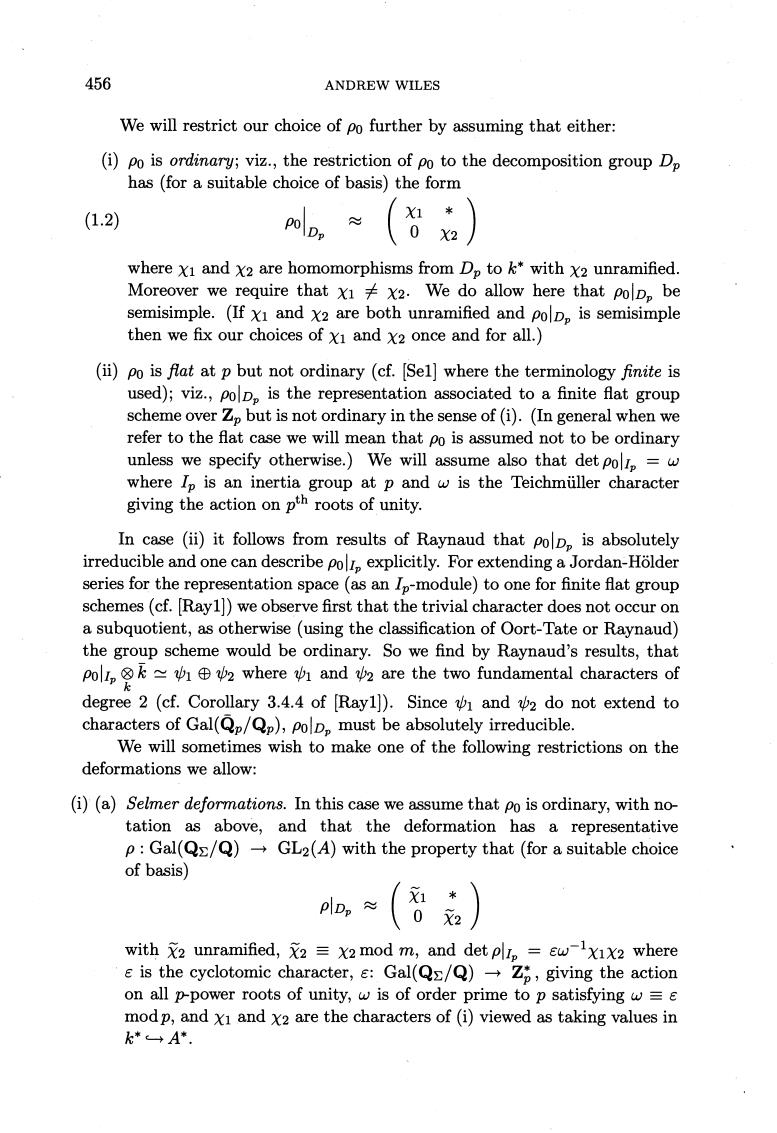正在加载图片...

456 ANDREW WILES We will restrict our choice of po further by assuming that either: (i)po is ordinary;viz.,the restriction of po to the decomposition group Dp has (for a suitable choice of basis)the form (1.2) where xi and x2 are homomorphisms from Dp tokwith x2 unramified. Moreover we require that x1x2.We do allow here that polp,be semisimple.(If xI and x2 are both unramified and poD is semisimple then we fix our choices of xi and x2 once and for all.) (ii)oisfat atp but not ordinary (cf.Sel]where the terminology finite is used);viz.,polD,is the representation associated to a finite flat group scheme over Zp but is not ordinary in the sense of(i).(In general when we refer to the flat case we will mean that po is assumed not to be ordinary unless we specify otherwise.)We will assume also that detpo where Ip is an inertia group at p and w is the Teichmuiller character giving the action on pth roots of unity. In case (ii)it follows from results of Raynaud that polD,is absolutely irreducible and one can describe polr explicitly.For extending a Jordan-Holder series for the representation space(as an p-module)toone for finite flat group schemes(cf.Ray1])we observe first that the trivial character does not occur on a subquotient,as otherwise (using the classification of Oort-Tate or Raynaud) the gro oup scheme would be ordinary.So we find by Raynaud's results,that PolIp≈h⊕2 where吻iand2 are the two fundamental characters of degree 2(cf.Corollary 3.4.4 of [Ray1]).Since v and 2 do not extend to characters of Gal(Qp/Qp),poD,must be absolutely irreducible. We will sometimes wish to make one of the following restrictions on the deformations s we allow (i)(a)Selmer deformations.In this case we assume that po is ordinary,with no tation above, and that the deformation s a representative P:Gal(Qs/Q)-GL2(A)with the property that (for a suitable choice of basis) with uramified,=xamod m,and detp =cw-1x1x2 where e is the cyclotomic character,Gal(Q/Q)Zp,giving the action on all p-power roots of unity,w is of order prime to p satisfying w=e modp,and xi and x2 are the characters of(i)viewed as taking values in A. 456 ANDREW WILES We will restrict our choice of po further by assuming that either: (i) po is ordinary; viz., the restriction of po to the decomposition group D, has (for a suitable choice of basis) the form where XI and x2 are homomorphisms from D, to kt with ~2 unramified. Moreover we require that XI # ~2.We do allow here that polDp be semisimple. (If XI and ~2 are both unramified and polDp is semisimple then we fixour choices of XI and ~2 once and for all.) (ii) po is flat at p but not ordinary (cf. [Sell where the terminology finite is used); viz., polDp is the representation associated to a finite flat group scheme over Z, but is not ordinary in the sense of (i). (In general when we refer to the flat case we will mean that po is assumed not to be ordinary unless we specify otherwise.) We will assume also that det polIp = w where I, is an inertia group at p and w is the Teichmiiller character giving the action on pth roots of unity. In case (ii) it follows from results of Raynaud that polDp is absolutely irreducible and one can describe po 1 Ip explicitly. For extending a Jordan-Hijlder series for the representation space (as an I,-module) to one for finite flat group schemes (cf. [Rayl]) we observe first that the trivial character does not occur on a subquotient, as otherwise (using the classification of Oort-Tate or Raynaud) the group scheme would be ordinary. So we find by Raynaud's results, that pc11, k " $1 @ $2 where $1 and $2 are the two fundamental characters of degree 2 (cf. Corollary 3.4.4 of [Rayl]). Since $1 and q2 do not extend to characters of Gal(Q,/Q,) , po 1 D p must be absolutely irreducible. We will sometimes wish to make one of the following restrictions on the deformations we allow: (i) (a) Selmer deformations. In this case we assume that po is ordinary, with notation as above, and that the deformation has a representative p : Gal(Qc/Q) + GL2(A) with the property that (for a suitable choice of basis) with unramified, g2 = ~2 mod m, and det plIp = E W - where ~ ~ ~ ~ ~ E is the cyclotomic character, E: Gal(Qc/Q) + Z;, giving the action on all ppower roots of unity, w is of order prime to p satisfying w = E modp, and XI and ~2 are the characters of (i) viewed as taking values in kt -A*